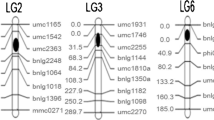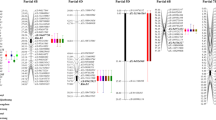Abstract
We have mapped the quantitative trait loci (QTLs) conferring resistance to sorghum downy mildew (Peronosclerospora sorghi; SDM) and Rajasthan downy mildew (P. heteropogoni; RDM), two species of DM prevalent throughout India. QTL mapping was carried out on a backcross population of 151 individuals derived from a cross between CM139 (susceptible parent) and NAI116 (highly resistant to both SDM and RDM). Heritability estimates were 0.74 for SDM and 0.67 for RDM. Composite interval mapping combined with a linkage map constructed with 80 simple sequence repeat (SSR) markers resulted in the identification of three QTLs (one each on chromosomes 2, 3 and 6) for SDM resistance and two QTLs (one each on chromosomes 3 and 6) for RDM resistance, all of which were contributed by NAI116. The significance of the major QTL on chromosome 6 (bin 6.05) that confers resistance to diverse DMs in tropical Asia, including SDM and RDM in India, was also verified. The results confirmed that some common QTLs contribute to both SDM and RDM resistance, while additional loci might specifically govern resistance to SDM. The QTL information generated in this study provide information that will aid in undertaking an integrated breeding strategy for the transfer of resistance to SDM and RDM in maize lines using marker-assisted selection.


Similar content being viewed by others
References
Agrama HA, Moussa ME, Naser ME, Tarek MA, Ibrahim AH (1999) Mapping of QTL for downy mildew resistance in maize. Theor Appl Genet 99:519–523
Beavis WD, Keim P (1996) Identification of quantitative trait loci that are affected by environment. In: Kang MS, Gauch HG (eds) Genotype-by-environment interaction. CRC Press, Boca Raton, pp 123–129
Beavis WD, Grant D, Albertsen M, Fincher R (1991) Quantitative trait loci for plant height in four maize populations and their association with qualitative trait loci. Theor Appl Genet 83:161–165
Bohn M, Khairallah MM, Jiang C, Gonzalez-de-Leon D, Hoisington DA, Utz HF, Deutsch JA, Jewell DC, Mihm JA, Melchinger AE (1997) QTL mapping in tropical maize. II. Comparison of genomic regions for resistance to Diatraea spp. Crop Sci 37:1892–1902
Bonde MR (1982) Epidemiology of downy mildew diseases of maize, sorghum and pearl millet. Trop Pest Manage 28:49–60
Churchill GA, Doerge RW (1994) Empirical threshold values for quantitative trait mapping. Genetics 138:963–971
Craig J, Bockholdt AJ, Frederiksen RA, Zuber MS (1977) Reaction of important corn inbred lines to Sclerospora sorghi. Plant Dis Rep 61:563–564
Frederiksen RA, Bockholt AJ, Clark LE, Cosper JW, Craig J, Johnson JW, Jones BL, Matocha P, Miller, Reyes L, Rosenow DT, Tuleen D, Walker HJ (1973) Sorghum downy mildew, a disease of maize and sorghum. Texas Agricultural Experiment Station Monograph 2, Aransas, Tex.
George MLC, Prasanna BM, Rathore RS, Setty TAS, Kasim F, Azrai M, Vasal S, Balla O, Hautea D, Canama A, Regalado E, Vargas M, Khairallah M, Jeffers D, Hoisington D (2003) Identification of QTLs conferring resistance to downy mildews of maize in Asia. Theor Appl Genet 107:544–551
Groh S, Gonzalez-de-Leon D, Khairallah M, Jiang C, Bergvinson D, Bohn M, Hoisington D, Melchinger AE (1998) QTL mapping in tropical maize. III. Genomic regions for resistance to Diatraea spp. and associated traits in two RIL populations. Crop Sci 38:1062–1072
Hoisington D, Khairallah M, González-de-León D (1994) Laboratory protocols: CIMMYT Applied Molecular Genetics Laboratory, 2nd edn. CIMMYT, Mexico, DF
Jeffers D, Cordova H, Vasal S, Srinivasan G, Beck D, Barandiaran M (2000) Status in breeding for resistance to maize diseases at CIMMYT. In: Vasal SK, Gonzalez Ceniceros F, Xingming F (eds) Proc 7th Asian Regional Maize Workshop. PCARRD, Los Baños, Philippines, pp 257–266
Kearsey MJ, Pooni HS (1996) The genetical analysis of quantitative traits. Chapman & Hall, London
Knapp SJ, Stroup WW, Ross WM (1985) Exact confidence intervals for heritability on a progeny mean basis. Crop Sci 25:192–194
Lander ES, Green P, Abrahamson J, Barlow A, Daly MJ, Lincoln SE, Newburg L (1987) mapmaker: an interactive computer package for constructing primary genetic linkage maps of experimental and natural populations. Genomics 1:174–181
Lubberstedt T, Klein D, Melchinger AE (1998a) Comparative QTL mapping of resistance to Ustilago maydis across four populations of European flint maize. Theor Appl Genet 97:1321–1330
Lubberstedt T, Klein D, Melchinger AE (1998b) Comparative quantitative trait loci mapping of partial resistance to Puccinia sorghi across four populations of European flint maize. Phytopathology 88:1324–1329
Luo ZW, Kearsey MJ (1991) Maximum likelihood estimation of linkage between a marker gene and a quantitative trait locus. II. Application to backcross and doubled haploid populations. Heredity 66:117–124
Melchinger AE, Kuntze L, Gumber RK, Lubberstedt T, Fuchs E (1998) Genetic basis of resistance to sugarcane mosaic virus in European maize germplasm. Theor Appl Genet 96:1151–1161
Nair SK, Prasanna BM, Rathore RS, Setty TAS, Kumar R, Singh NN (2004a) Genetic analysis of resistance to sorghum downy mildew and Rajasthan downy mildew in maize (Zea mays L.). Field Crops Res 89:379–387
Nair SK, Prasanna BM, Rathore RS, Setty TAS, Kumar R, Singh NN (2004b) Genetic variability in the Indian maize germplasm for resistance to sorghum downy mildew (Peronosclerospora sorghi) and Rajasthan downy mildew (P. heteropogoni). Maydica 49:57–64
Pingali PL, Pandey S (2001) Meeting world maize needs: technological opportunities and priorities for the public sector. In: Pingali PL (ed) CIMMYT 1999/2000 World maize facts and trends. CIMMYT, Mexico, DF, pp 1–24
Rathore RS, Siradhana B (1987) Estimation of losses caused by Perenosclenospora heteropogoni on Ganga-5 maize hybrid. Phytophylactica 19:119–120
Raymundo AD (2000) Downy mildew of maize in Asia: new perspectives in resistance breeding. In: Vasal SK, Gonzalez Ceniceros F, Xingming F (eds) Proc 7th Asian Regional Maize Workshop. PCARRD, Los Banos, Philippines, pp 277–284
Ribaut J-M, Bertran FJ (1999) Single large-scale marker-assisted selection (SLS-MAS). Mol Breed 5:531–541
Rifin A (1983) Downy mildew resistance of single cross progenies between Indonesia and Philippine corn inbred lines. Penelitian Pertanian 3:81–83
Saghai-Maroof MA, Soliman KM, Jorgensen RA, Allard RW (1984) Ribosomal DNA spacer length polymorphism in barley: Mendelian inheritance, chromosomal location and population dynamics. Proc Natl Acad Sci USA 81:8014–8018
Schmidt CG, Freytag RE (1977) Response of selected resistant maize lines to three species of Sclerospora. Plant Dis Rep 61:478–481
Searle SR (1971) Linear models. Wiley, New York
Sharma RC, De-Leon C, Payak MM (1993) Diseases of maize in south and south-east Asia: problems and progress. Crop Protect 12:414–422
Siradhana B, Dange SRS, Rathore RS, Singh SD (1980) A new downy mildew on maize in Rajasthan, India. Curr Sci 49:316–317
Spencer MA, Dick MW (2002) Aspects of graminicolous downy mildew biology: perspectives for tropical plant pathology and Peronosporomycetes phylogeny. In: Watling R, Frankland JC, Ainsworth AM, Isaac S, Robinson CH (eds) Tropical mycology, vol 2. Micromycetes. CABI Publ, Wallingford, pp 63–81
Wang XYW, Kim CS, Larkins BA (2001) Quantitative trait locus mapping of loci influencing Elongation Factor-1α content in maize endosperm. Plant Physiol 125:1271–1282
Wang S, Basten CJ, Zeng ZB (2004) Windows qtlcartographer 2.0. Department of Statistics, North Carolina State University, Raleigh, NC. (http://statgen.ncsu.edu/qtlcart/WQTLCart.htm)
Yen TTO, Prasanna BM, Setty TAS, Rathore RS (2004) Genetic variability for resistance to sorghum downy mildew (Peronosclerospora sorghi) and Rajasthan downy mildew (P. heteropogoni) in tropical/sub-tropical Asian maize germplasm. Euphytica 138:23–31
Zeng ZB (1994) Precision mapping of quantitative trait loci. Genetics 136:1457–1468
Acknowledgements
The study was carried out under the Asian Maize Biotechnology Network (AMBIONET) program in India, with financial support from the Asian Development Bank. We thank Mr. Govindraju and Dr. R. Kumar for their help with the field experiments. The first author (SKN) was also supported by a UGC Junior Research Fellowship and Senior Research Fellowship.
Author information
Authors and Affiliations
Corresponding author
Additional information
Communicated by D.A. Hoisington
Rights and permissions
About this article
Cite this article
Nair, S.K., Prasanna, B.M., Garg, A. et al. Identification and validation of QTLs conferring resistance to sorghum downy mildew (Peronosclerospora sorghi) and Rajasthan downy mildew (P. heteropogoni) in maize. Theor Appl Genet 110, 1384–1392 (2005). https://doi.org/10.1007/s00122-005-1936-5
Received:
Accepted:
Published:
Issue Date:
DOI: https://doi.org/10.1007/s00122-005-1936-5




